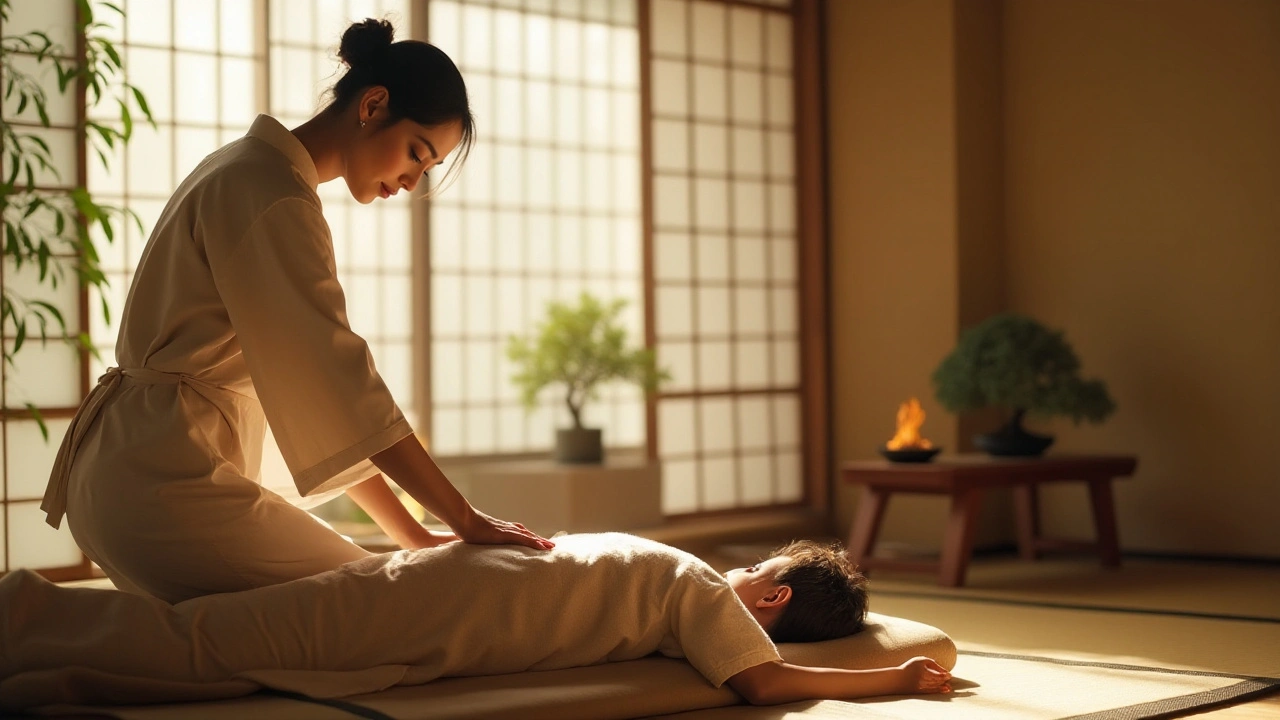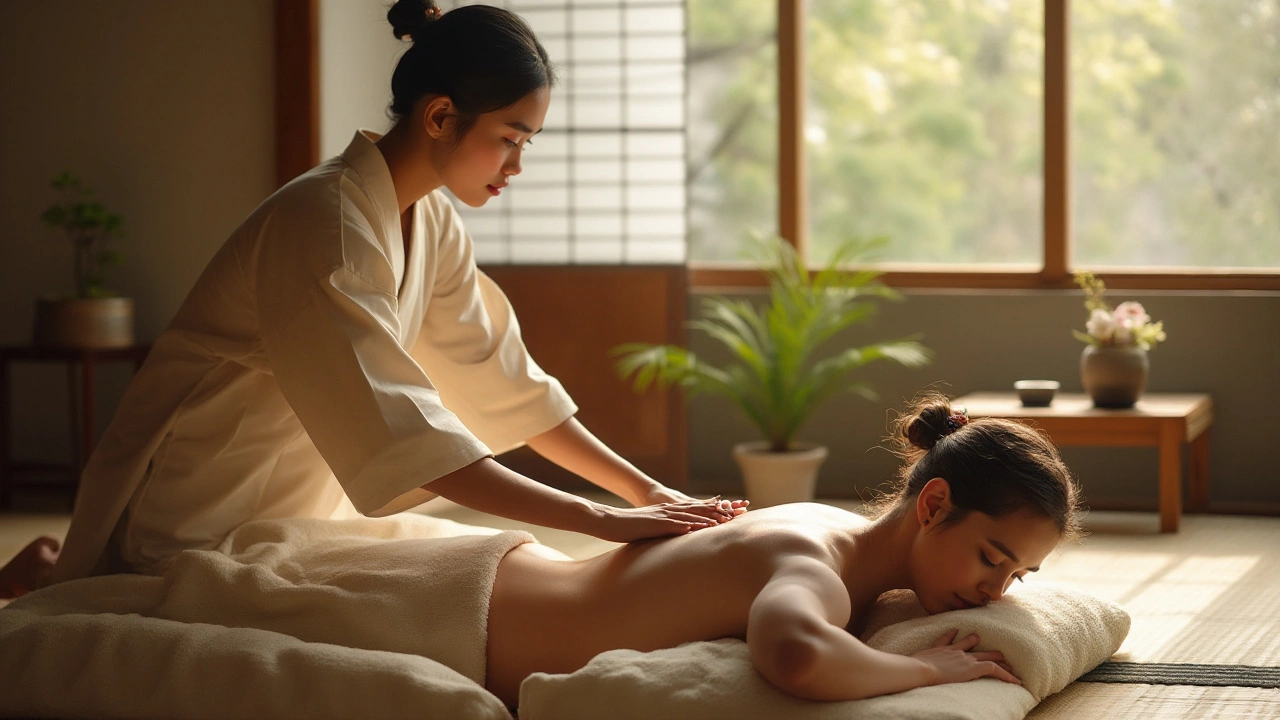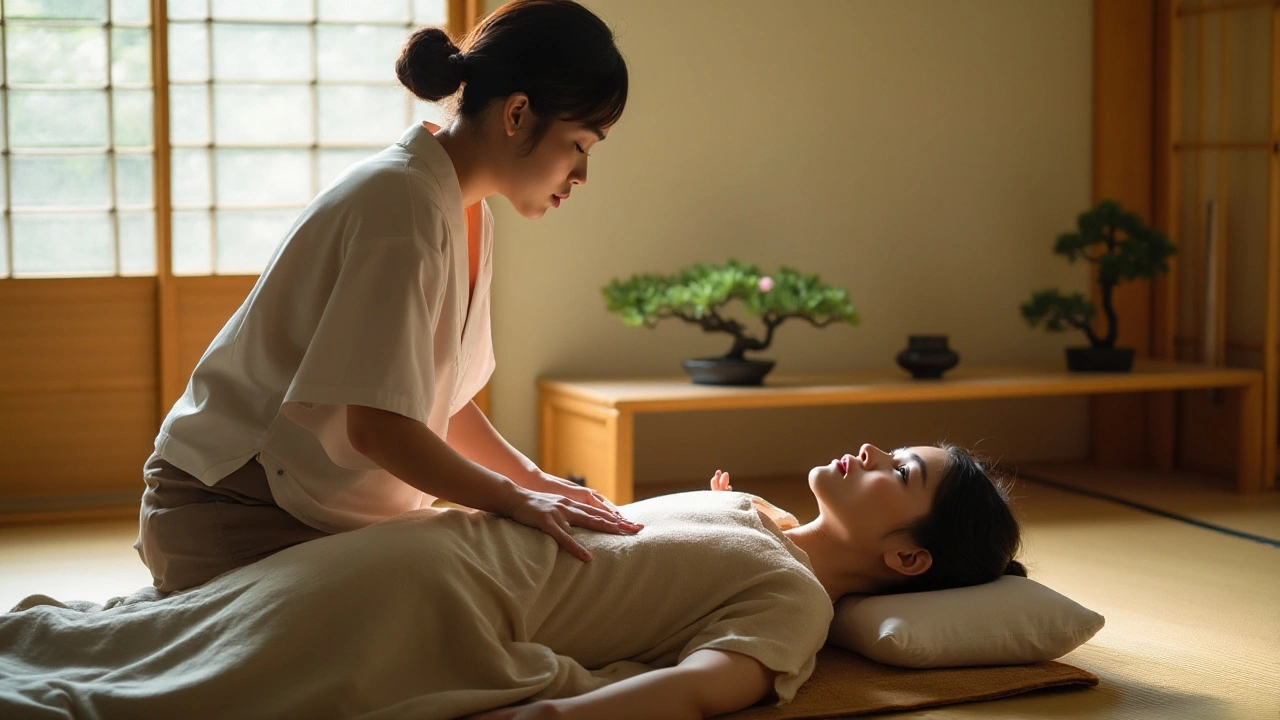Shiatsu massage isn't just a treatment; it's a journey into relaxation and balance. Originating from Japan, this ancient technique emphasizes the harmonious flow of energy throughout the body. Exploring Shiatsu reveals more than just its rich history; it uncovers its profound benefits for both the body and mind.
By applying gentle pressure to specific points, Shiatsu helps to release stress, improve circulation, and promote overall wellness. Whether you're seeking relief from chronic aches or simply aiming to enhance your mental clarity, this holistic approach offers a natural way to achieve that balance.
Ever wondered about the science behind Shiatsu? Modern studies illuminate its effectiveness and how it works on a physiological level. And the best part? You don't need a professional therapist to experience its benefits; there are simple techniques you can practice at home.
If you're ready to dive into a practice that connects your physical and mental well-being, Shiatsu massage awaits. It's not just a technique but a lifestyle shift towards lasting peace and vitality.
- Origins and Principles of Shiatsu Massage
- Benefits of Shiatsu for Mind and Body
- Scientific Insights into Shiatsu
- Practical Tips for Incorporating Shiatsu
Origins and Principles of Shiatsu Massage
Shiatsu massage is a unique therapy that has its roots deeply embedded in ancient Japan. Its name translates to “finger pressure” in Japanese, highlighting the technique’s reliance on manual finger and palm pressure to enhance physical and mental well-being. Shiatsu’s development can be traced back to a combination of traditional Chinese medicine principles and Japanese massage methodologies that were passed down through generations. One pivotal figure in modern Shiatsu was Tokujiro Namikoshi, who formalized the practice and established the first Shiatsu school in 1940 in Hokkaido, Japan.
The main principle of Shiatsu is the concept of life energy, or “Qi” (pronounced “chee”), flowing through pathways in the body known as meridians. In Shiatsu philosophy, a balanced flow of Qi is essential for good health. When this flow is disrupted, it can lead to physical and emotional ailments. The goal of Shiatsu is to restore this balance by applying targeted pressure to specific points along the meridians. The therapist uses fingers, thumbs, palms, and sometimes even elbows to manipulate these points, promoting the body’s natural healing processes.
Interestingly, Shiatsu practitioners believe that physical health cannot be separated from mental and emotional balance. This holistic approach signifies a deep understanding that psychological stress can manifest as physical discomfort and vice versa. A session of Shiatsu might, therefore, address emotional tension just as much as it would target a sore lower back. This unique aspect of Shiatsu renders it not just a physical therapy but a comprehensive approach to achieving harmony within the body and mind.
One aspect that sets Shiatsu apart from other massage techniques is its personalized nature. A Shiatsu practitioner assesses the individual’s needs and tailors the treatment accordingly. This personalized care can lead to a more effective and meaningful healing experience. An emphasis on breathing and meditative focus during therapy sessions further enhances the relaxation and therapeutic elements of Shiatsu. The practice also encourages clients to maintain this mindfulness in their daily lives, integrating the lessons of balance and relaxation beyond the therapy session.
Traditional Shiatsu has many forms and has evolved over the years. Some schools emphasize vigorous and rhythmic pressure, while others incorporate gentle and sustained pressure. Despite these variations, the foundational philosophy remains consistent: to harmonize the body’s energy flow. According to a study published in the Journal of Alternative and Complementary Medicine, Shiatsu has been shown to reduce anxiety and decrease the severity of various symptoms, highlighting its effectiveness in improving overall quality of life.
"Shiatsu is more than a physical technique; it’s a pathway to connect with our inner self and understand the intricate balance between body and mind." –Haruko Kataoka, Shiatsu Master

Benefits of Shiatsu for Mind and Body
The practice of Shiatsu massage can bring myriad benefits to both your mind and body. Often referred to as 'finger pressure', this unique therapy taps into the body's own healing abilities by targeting specific points. By doing so, it aims to unblock pathways where energy, or 'qi', might be stuck. But what exactly does that mean in tangible terms for your health?
First and foremost, Shiatsu is well-known for its stress-relieving properties. In our fast-paced world, stress is a common ailment that often goes untreated. Through the application of rhythmic pressure, Shiatsu helps activate the parasympathetic nervous system. This system is responsible for calming the body and mind, reducing anxiety levels. Many individuals report feeling a profound sense of relaxation after a session, and there's evidence suggesting regular Shiatsu can help in managing chronic stress.
Physical benefits of Shiatsu are just as impressive. It enhances blood circulation, which is vital for delivering nutrients and oxygen to different parts of the body. Improved circulation can alleviate conditions such as headaches and muscle tension. Often, poor circulation can lead to chronic pain, and addressing this through Shiatsu can provide long-term relief. Additionally, regular sessions can improve flexibility and range of motion by loosening up tight muscles and joints.
A lesser-known benefit is its positive impact on the digestive system. Shiatsu helps regulate the digestive organs by stimulating them, which can aid in better digestion and even alleviate conditions such as constipation and indigestion. As the pressure is applied to various points, it sends signals to the brain to release natural painkillers and feel-good hormones like endorphins and serotonin, which improve digestion and overall well-being.
According to Dr. Masa Suzuki, a renowned Shiatsu practitioner, "The beauty of Shiatsu lies in its simplicity and effectiveness. It harmonizes the body's energy flow and restores balance, making it a powerful tool for health maintenance."
Mental clarity and emotional balance are another big win from practicing Shiatsu. By calming the mind and reducing stress hormones, this technique can lead to better focus, emotional stability, and a general feeling of happiness. This is particularly beneficial for people dealing with mental health issues such as depression and anxiety. When your mind is clear and relaxed, you're more equipped to tackle the challenges of daily life.
It's also notable how Shiatsu strengthens the immune system. Regular sessions can help maintain optimal bodily functions, making your system more resilient against illnesses. When stress levels are managed and circulation is improved, your body’s natural defense mechanisms are better equipped to fight off infections and diseases. This makes Shiatsu not just a treatment but a preventive health measure.
Lastly, Shiatsu encourages self-awareness and connection with one’s own body. In our daily grind, it’s easy to overlook how we truly feel, physically and emotionally. The mindful practice encourages you to tune into your body’s signals, helping you recognize and address issues before they escalate.
If you’re someone looking to enhance your holistic wellness, Shiatsu is more than just a massage; it’s a pathway to a balanced, healthy life. By integrating it into your routine, you can enjoy these numerous benefits and thrive in a more harmonious state of being.

Scientific Insights into Shiatsu
The art of Shiatsu massage isn't merely an ancient tradition; it’s increasingly backed by contemporary scientific research. Shiatsu, which means 'finger pressure' in Japanese, primarily uses touch, stretches, and joint rotations to stimulate the body's natural energy flow. The practice is anchored in the concept of 'Qi' (or 'Chi'), the vital life force that flows through our bodies. When Qi is blocked or unbalanced, it can lead to physical and emotional disturbances. Shiatsu aims to restore balance, ensuring the smooth flow of this energy.
Modern studies have delved into how Shiatsu affects physiological processes. Research published in the journal 'BioPsychoSocial Medicine' demonstrates that Shiatsu can significantly reduce stress and improve quality of sleep. The study revealed that patients who received regular Shiatsu treatments showed lower levels of cortisol, a stress hormone. This reduction in cortisol levels directly correlates with improved mood and decreased anxiety.
Another intriguing study involves the effects of Shiatsu on musculoskeletal pain. Published in ‘The Journal of Alternative and Complementary Medicine,’ this research found that individuals suffering from chronic neck and back pain experienced significant relief after consistent Shiatsu sessions. The gentle pressure applied during Shiatsu enhances blood circulation, which helps to reduce inflammation and pain. Additionally, the deep relaxation induced by the treatment aids the release of endorphins, the body's natural painkillers.
Shiatsu’s impact on mental health has also garnered attention. A notable study highlighted in 'Psychology Today' concluded that regular Shiatsu treatments could alleviate symptoms of depression. Through the therapeutic touch, Shiatsu promotes the production of serotonin and dopamine, the neurotransmitters responsible for feelings of happiness and well-being. This natural boost helps mitigate the effects of depression, making Shiatsu a valuable adjunctive treatment for mental health.
Dr. Kimiko Nakamura, a respected expert in holistic health, states, "Shiatsu effectively bridges the gap between physical health and emotional well-being. It works on multiple levels, offering a comprehensive approach to healing."
Scientific validation of Shiatsu’s benefits doesn't stop at mental health improvements. The technique has also shown promise in enhancing the immune system. A study conducted by the University of Tokyo found that regular Shiatsu sessions could increase white blood cell activity. These cells are crucial for combatting infections and keeping the body resilient against diseases. This immune-boosting effect highlights Shiatsu’s role in preventive healthcare, offering a natural way to bolster the body’s defenses.
Understanding the science behind Shiatsu provides a deeper appreciation of its holistic approach. It's not just about pressing points but about the interconnectedness of our body systems. The cumulative effect of these physiological changes underscores why Shiatsu remains a revered practice. It’s an enriching blend of tradition and modern health benefits that offer a comprehensive route to overall well-being.

Practical Tips for Incorporating Shiatsu
Integrating Shiatsu massage into your daily routine doesn't require any special equipment or a visit to a professional, though those can certainly enhance the experience. Here are some practical tips to make the most out of Shiatsu in your everyday life. First and foremost, establish a regular schedule. Consistency enhances the benefits of Shiatsu, which include improved circulation and stress relief. Choose a quiet time each day where you can focus solely on yourself, undisturbed.
The next step is creating a tranquil environment. Dedicate a space in your home that feels peaceful and free from distractions. This can be as simple as a corner with a comfortable mat or a few cushions. Soft lighting, calming music, or even nature sounds can further set the mood. Remember, the environment significantly influences the efficacy of your practice.
Learning the basic techniques of Shiatsu can greatly amplify your self-care routine. Resources like instructional videos, books, and online courses are readily available. Begin with the fundamentals, such as applying gentle pressure using your fingers, thumbs, and palms. Focus on key points along the body's energy pathways, known as meridians, to alleviate tension and promote balance.
"One of the simplest yet most effective techniques in Shiatsu involves applying steady, consistent pressure to specific points," notes Dr. Megumi Yamamoto, a renowned expert in Japanese massage therapies. "It’s a practice that offers immediate relief and long-term benefits."
Incorporating breathwork can enhance the effects of Shiatsu. Deep, mindful breathing helps to synchronize your body's energy, making the massage more effective. Breathe deeply and slowly, focusing on each inhale and exhale. This not only relaxes the body but also clears the mind, creating a holistic experience. Don't hesitate to combine Shiatsu with other wellness practices. Gentle stretching or yoga can complement the massage, enhancing flexibility and relaxation. These activities work synergistically to improve your overall well-being.
If you're short on time, even brief sessions can make a difference. A quick 5-minute routine focusing on the neck, shoulders, and hands can be incredibly rejuvenating. Allocate specific time slots during breaks or before bedtime to ensure you incorporate these mini-sessions into your day. Consistency is key here, too; even short, regular practice can yield significant benefits over time.
Additionally, be mindful of your body's signals. Shiatsu should never be painful. If you experience discomfort, reduce the pressure or try a different technique. Listen to what your body is telling you, and adjust your practice accordingly. This mindfulness ensures that Shiatsu remains a positive and healing experience.
Don't overlook the importance of hydration. Drinking plenty of water before and after your Shiatsu session helps to flush out toxins and keeps your muscles supple. Proper hydration supports your body's natural healing processes, augmenting the benefits of the massage. Lastly, consider sharing the experience with a partner. Practicing Shiatsu with a friend or loved one can deepen your connection and provide mutual benefits. Take turns delivering and receiving the massage, and enjoy the relaxation and bonding that come with it.


 Health and Wellness
Health and Wellness